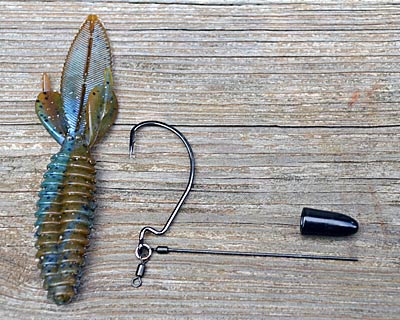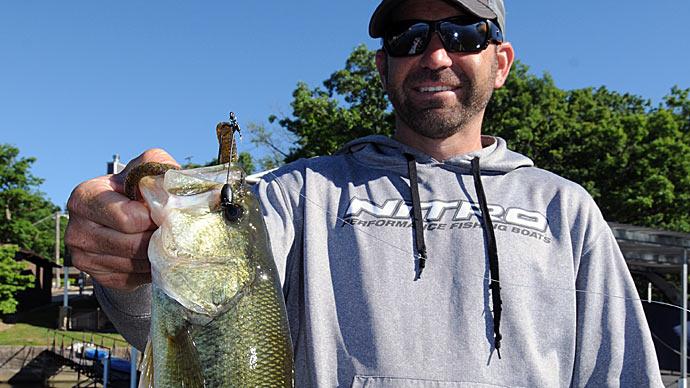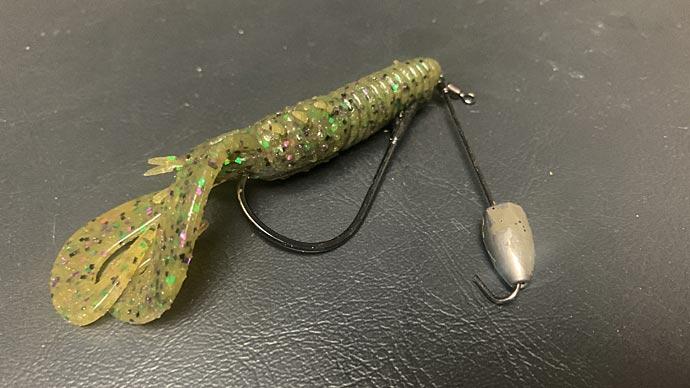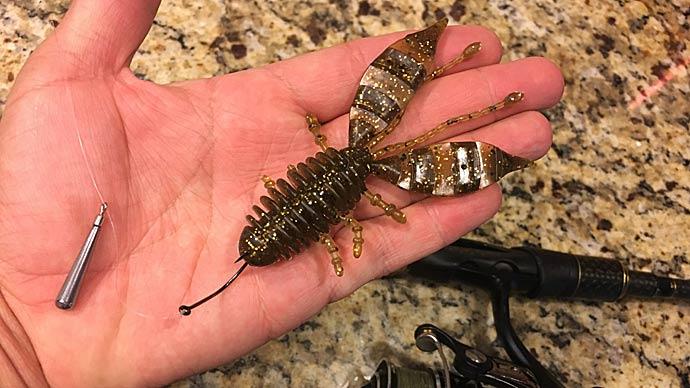
It was different. It was bulky. “It didn’t look like it would catch a fish,” said Bassmaster Elite Series angler Seth Feider. “There was a lot of hardware on there.”
Feider’s first impression wasn’t off base. Straight from the package, a Tokyo rig includes a hook, swivel, welded ring, and a dropper made of single-strand wire. It looks more like a live-bait rig built for powerful saltwater fish that sport plenty of sharp teeth. But on closer inspection, it’s most similar to a popular freshwater rig. “I didn’t understand then that it was like a drop shot, but it is,” he said.
The Tokyo rig matched the fish-catching power of a drop shot the first time Feider fished it, sinking his first-look concerns. It impressed him in other ways, too. “It’s pretty versatile,” he said. On the spectrum of fishing lure types, he puts the Tokyo rig between finesse lures and jigs. He can fish it for largemouth or smallmouth and in deep or shallow water.
Sizing it up
Most bass fishing fans associate Feider with smallmouth, which he targeted to win a recent Toyota Bassmaster Angler of the Year Championship on Mille Lacs Lake in his home state of Minnesota. But living among so many natural lakes — 10,000 at last count — he also has developed a soft spot for largemouth, especially when he can catch them flipping, pitching, and dipping into submerged aquatic vegetation such as milfoil and coontail. And that’s his favorite situation to fish a Tokyo rig.
Feider has tried a punch shot, a shorter version of a drop shot that uses heavier line and weight, and a bigger hook and lure. It’s intended to survive heavy cover and suspend a soft-plastic lure off the bottom, allowing you to impart action without moving it from one spot. He said a Tokyo rig can do all that a punch shot can and more.
Punch shots often foul in heavy cover, the flexible line between the hook and weight wrapping around brush and vegetation as it sinks. Feider said the Tokyo rig’s down wire eliminates that problem. And the rig’s hinged design allows it to easily slip into heavy cover, especially aquatic vegetation, weight forward, like a jig or Texas rig. Once its weight reaches the bottom, it returns to its designed stance with the lure kicked out to the side. He fishes it much like a drop shot, casting it to specific spots, keeping the weight on the bottom, and shaking the slack in his line by quickly twitching his rod tip.

Feider catches his fair share of smallmouth on a Tokyo rig, but he fishes it differently to catch them. He steadily pulls it across the bottom, dragging it over rock, sand, and other hard-bottom spots. The approach is much like how swinging head football jigs are fished.
Mopping up
Feider has a Tokyo rig when he’s fishing submerged aquatic vegetation for largemouth bass. But it’s never the first lure he grabs. “I rarely start with it,” he said.
The Tokyo rig is not a silver bullet for Feider. Like every other lure and technique in his arsenal, it works best when thrown at a specific target. And for him, that’s pressured bass, such as those swimming in Lake Minnetonka outside Minneapolis. He said that if you find a school of bass in the grass, it is good that seven or eight other anglers have found them, too. And if they are all fishing Texas-rigged soft plastics and jigs for them, he believes the Tokyo rig gives bass something different to look at, which increases his chances of catching them.
Feider always starts with a jig or Texas-rigged soft plastics in pressured-bass situations. But before he leaves, he makes a few more passes with a Tokyo rig, mopping up any bass that weren’t interested in his earlier offering. “I catch twice as many now versus hitting them in the head with just a jig or Texas rig,” he said. “You can go back with [a Tokyo rig] and clean up.”
Feider has fished a Tokyo rig on lakes where bass see little fishing pressure, making them eager to eat any lure they come across. In those situations, he usually catches everything on a jig or Texas-rigged soft plastics. And that doesn’t leave anything for a final pass with a Tokyo rig.
Rigging up
The Tokyo rig’s versatility goes beyond where it can be fished. Sold without a weight, you can add as much or as little as you want. Several hook sizes —2/0 to 5/0 — are offered in different styles, such as heavy flipping, round bend, and extra-wide gap. That allows you to create a rig that matches almost any fishing condition.

Feider prefers bullet-shaped weights, sliding them pointed side down when fishing vegetation, which helps them slide through as they sink. When fishing the rig across a hard bottom for smallmouth, he turns the sinker around so the wide end is down. That makes it less likely to wedge between rocks, snagging his rig. Attaching the weight is simple, though it requires a pair of pliers. Slide one on the wire then bends the end over. It should freely slide on the wire.
Feider chooses the weight on his Tokyo rig based on the thickness of the cover he is fishing. He has added as much as 1 1/2 ounces on one when punching through matted aquatic vegetation. But heavy weights aren’t the norm. He has found that these rigs need less weight than the jig or Texas rig that he would fish on the same spot. If he would fish a 3/4-ounce jig or 5/8-ounce Texas rig, he’ll only add a 3/8-ounce weight to his Tokyo rig.
Hook style and size match the soft-plastic lure Feider is fishing. He prefers the smaller 2/0 size in two situations. He’ll choose a Tokyo rig with an extra-wide gap hook in that size for dragging 3.25-inch swimbaits for smallmouth. And he’ll use a round-bend version to wacky rig a stick worm. The latter offers a subtle presentation that even the most stubborn largemouth can’t resist. “That’s my last resort on the schools,” he said.
As the cover gets thicker and the bass bigger or more aggressive, Feider selects a Tokyo rig with a larger and stronger hook. He uses one sporting a 4/0 extra-wide gap, for example, when fishing tubes or a creature bait such as BioSpawn’s Vile Craw. They plane better than other styles of soft plastics, he said, bringing more action when he shakes his Tokyo rig.
Regardless of which soft-plastic lure or weight Feider threads on his Tokyo rig, he throws it on the same outfit. It starts with a 7-foot Daiwa Tatula Elite casting rod designed by Major League Fishing angler Brent Ehrler. The rod sports a medium-heavy action. He attaches a Daiwa Tatula SV casting reel with an 8:1 gear ratio to the rod. He spools it with 30-pound test Sufix 832 braid, adding several feet of 20-pound test Sufix Advance fluorocarbon line as a leader. He might switch to a lighter pound test leader when he’s targeting smallmouth if cover is sparse and the water is clear, but that’s not always a given. “It doesn’t seem to matter when winding it along,” he said.
Using braided line for his main line offers a distinct advantage. Feider said its strength allows him to use a shorter and lighter power rod than if he was fishing straight monofilament or fluorocarbon line. It weighs less, reducing fatigue and keeping him fishing all day.
BassResource may receive a portion of revenues if you make a purchase using a link above.




